

(12) Het Nieuwe Werken is Sociocratisch. The BetaCodex white papers (Vol. 1-16) - BetaCodex Network. The Root Cause of Employee Demotivation - The Startup - Medium. Bernhard Possert - Mein Stil. (146) Interview Kurt Peleman - Zwijgen is geen optie. Dan Pallotta: The way we think about charity is dead wrong. 10 Components That Successfully Abolished Hierarchy (In 70+ Companies)
How a U.S. Health Care System Uses 15-Minute Huddles to Keep 23 Hospitals Aligned. Executive Summary A core challenge of management is to ensure that the organization’s priorities, strategies, and metrics are consistently embraced and that any impediments are identified and addressed quickly.

At Salt Lake City-based Intermountain Healthcare, ensuring the alignment of all these things to provide extraordinary care requires a constant regimented focus across its 23 hospitals, 170 clinics, and 850,000-member health insurance plan. To achieve that, it has implemented a model of daily huddles on an extensive scale. In this article, Intermountain’s CEO shares the insights gleaned from the model’s first full year of operation that organizations in health care and many other industries will find useful. A core challenge of management is to ensure that the organization’s priorities, strategies, and metrics are consistently embraced and that any impediments are identified and addressed quickly. Your browser isn't supported. A Better Way to Test Objections in Holacracy® – Chris Cowan, EdD., MDiv.
This post is oriented a bit towards facilitators, but it should be helpful for anyone who wants to understand objections a little better.
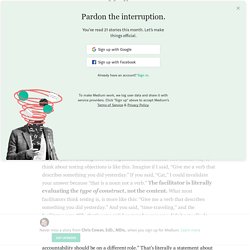
What the facilitator is actually judging.The Facilitator is judging whether the objector’s argument is reasoned, not reasonable. A Better Way to Test Objections in Holacracy® – Chris Cowan, EdD., MDiv. Putting humans - not roles - front and centre in modern organisations. Self-managing organisations are a huge leap forward from traditional management hierarchy.
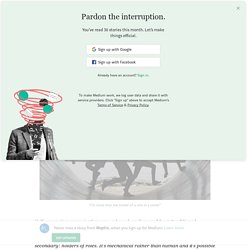
Yet there’s a trend to think of self-managing organisations as collections of roles. In this view, humans are something secondary: holders of roles. It’s mechanical rather than human and it’s possible to do better. Instead you can work with a far more natural, human creative process. And ensure success by prioritising self-development over organisational processes. Complexity Demands New Approaches to Work. The workplace is in massive flux.
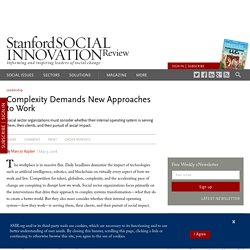
Daily headlines dramatize the impact of technologies such as artificial intelligence, robotics, and blockchain on virtually every aspect of how we work and live. Competition for talent, globalism, complexity, and the accelerating pace of change are conspiring to disrupt how we work. Social sector organizations focus primarily on the interventions that drive their approach to complex systems transformation—what they do to create a better world.
But they also must consider whether their internal operating system—how they work—is serving them, their clients, and their pursuit of social impact. Many organizations are stuck in antiquated structures that impede rather than enable employees to bring their best selves to work. Nonprofits have adopted business practices for decades to professionalize and improve accountability. Culture Doesn’t Come Later – NOBL. Sociocracy 3.0. All the materials we create are licensed to you under a which is a Free Culture License.
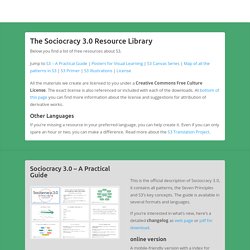
Basically this license grants you: Freedom to use the work itself.Freedom to use the information in the work for any purpose, even commercially.Freedom to share copies of the work for any purpose, even commercially.Freedom to make and share remixes and other derivatives for any purpose. 10 Components That Successfully Abolished Hierarchy (In 70+ Companies) Geen bazen of hiërarchie meer, dit Gentse bedrijf probeerde het uit. Dit is het resultaat:
Magazine - Itinéraires pour une Société Collaborative. The five trademarks of agile organizations. This article was written collaboratively by the McKinsey Agile Tribe, a group of over 50 global colleagues bringing expertise from the digital, operations, marketing, and organization disciplines.

They integrate their deep experience and thought leadership to extract the best from McKinsey’s global experience as it helps organizations transform themselves into agile organizations. Our experience and research demonstrate that successful agile organizations consistently exhibit the five trademarks described in this article. The trademarks include a network of teams within a people-centered culture that operates in rapid learning and fast decision cycles which are enabled by technology, and a common purpose that co-creates value for all stakeholders. Dan Pallotta: The way we think about charity is dead wrong. We are wired to raise children in community – Frederic Laloux. In the West, a grand experiment has been unfolding over the last one hundred years.

For thousands of years, humans had been deeply embedded within a broader net of community life — fitted within the spheres of family, social class, faith, and work. But then we shed community and embraced the nuclear family as the container for our lives. We believed this small, isolated structure would allow us to create the lives we really wanted, unencumbered by the demands of extended families, meddling neighbors, and social pressures to conform. The demands of the collective gave way to the liberation of the individual as, at the turn of the twentieth century, rural dwellers piled into crowded cities seeking jobs. By mid-century, a post war economy made a new exodus possible, and life in the suburbs became the new ideal. More recently, hip urban centers with lively cafés, cool cultural centers, and app-reviewable restaurants have captured our collective imagination as the best place to live. What exactly are resilience and transformative resilience?
In ecosystems science, resilience research started more than 40 years ago.

In 1973, C.S. Holling published the first results of his studies of the complex dynamics of change within ecosystems. Resolving the awkward paradox in Frederic Laloux’s Reinventing Organisations. Update: May 2015.
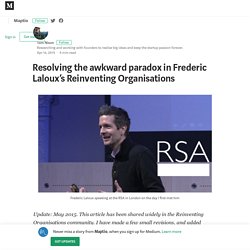
This article has been shared widely in the Reinventing Organisations community. I have made a few small revisions, and added comments directly from Frederic at the end. The confession Over dinner earlier this year, I confessed to Frederic Laloux that his best-selling book Reinventing Organisations was the very best business book I’d ever read that I couldn’t quite bring myself to recommend to others. How to create an agile organization. Transforming companies to achieve organizational agility is in its early days but already yielding positive returns.

While the paths can vary, survey findings suggest how to start. Rapid changes in competition, demand, technology, and regulations have made it more important than ever for organizations to be able to respond and adapt quickly. But according to a recent McKinsey Global Survey, organizational agility—the ability to quickly reconfigure strategy, structure, processes, people, and technology toward value-creating and value-protecting opportunities—is elusive for most. Many respondents say their companies have not yet fully implemented agile ways of working, either company-wide or in the performance units where they work, though the advantages are clear. Respondents in agile units report better performance than all others do, and companies in more volatile or uncertain environments are more likely than others to be pursuing agile transformations. Checklist voor future proof ondernemingen - MT.Be.
BILL REED: ON SHIFTING OUR MENTAL MODEL... - Helmer Van Weelderen. New Economic Spaces – Esko Kilpi – Medium. The new technological environment of business is marked by conflicting constraints and value-creating relationships that change rapidly and constantly. It is a complex environment. The Evolution of the Theory of Evolution. Darwinism and the Paradox of Altruism During the mid 1800s Charles Darwin upended both the scientific and religious worlds by releasing his seminal theory on biological evolution. Darwinism states that all species of organisms arise and develop through the natural selection of small, inherited variations that increase the individual’s ability to compete, survive, and reproduce. You Can’t Manage Complexity - Enlivening Edge. By Jon Freeman for Enlivening Edge Magazine Let’s make it clear from the start. You can’t “manage” complexity, and we will only begin to step into a second-tier world when we stop trying. The idea of managing organisational complexity has a long and deep history, with theories ranging from Bateson/Wiener/von Neumann Cybernetics [i] through Russell Ackoff [ii] Systems Thinking to McMaster’s iCAS [iii] (intelligent Complex Adaptive systems).
All of them are brilliant and none of them will deal with today’s levels of complexity. Nor were they truly sufficient to deal with yesterday’s. HolaSpirit - Application for Holacracy and teal organizations. Does Holacracy Have Blind Spots? – encode.org – Medium. All of the previous points are in no way meant to deny the tremendous value that Holacracy brought into the world by decentralizing authority and enabling self-organization in pursuit of organizational purpose.
Rather, we at encode.org perceive them as natural evolutionary tensions that come to the foreground with a mature practice of Holacracy: differentiating the organization from the people. The impulse that gave rise to encode.org is the curiosity to explore what’s next and to address the lingering tensions of self-organization from a higher vantage point. How the For-Purpose Enterprise Can Help We have developed and implemented the model of the For-Purpose Enterprise as a response to fill some of the legal, financial, and social gaps that companies using Holacracy (or other rulesets of self-organization) are facing. Co-creating regenerative enterprises – Daniel Christian Wahl – Medium. If the goal is to regenerate the health and vitality of living systems, then an enterprise will be most effective if it is designed: 1. To mimic living systems, following clearly defined ecosystem principles, 2. To be an integral part of living systems, building living capital through all their processes, and 3.
What is the pay system you dream of? Beyond the taboo of money. [Guest Blog] This Company Achieves 100% Customer Satisfaction With 0% Managers. How the public sector can remain agile beyond times of crisis. 25+ Fully Remote Companies That Let You Work From Anywhere. High-speed internet and powerful apps make it possible for just about anyone with a desk job to work from home.
Yet today most companies still insist that employees endure the sometimes soul-crushing commute to an office. How We Conduct 1:1s — NOBL Collective - The Future of Work. When you become a manager, or leader, your responsibility shifts. The Definitive Guide to Agile Retrospectives and Post-Mortem Meetings — NOBL Collective - The Future of Work. Peter Hinssen: "Loslaten van het traditionele managementmodel wordt hét vraagstuk van de 21ste eeuw" Foto: Peter Hinssen (bron: nexxworks) Hoe overleven in tijden van gigantisch snelle technologische vooruitgang? Untitled. Untitled. What’s Going On with Employee Empowerment? – NewCo Shift. You might have heard that Zappos has been struggling with a highly publicized move towards a “bossless”, self-management structure for their 1500 employees. Or maybe you’ve read that popular tech companies Medium, Buffer and GitHub have each stepped back from their self-management experiments. Cut the bullshit: organizations with no hierarchy don’t exist.
Do completely horizontal organizations truly exist? Fueled by growing excitement about self-management, bossless leadership and new governance models such as Holacracy, I increasingly hear large claims about the potential of “flat organizations”, which are being used as synonymous to “having no hierarchy”. Bylaws for a Sociocratic Organization.
This example is for an organization is based on the bylaws of a membership advocacy organization incorporated in Washington DC. 10 Surprising Things About Work Without Bosses. No CEO: The Swedish company where nobody is in charge. Why isn't Holacracy working at Zappos? — Quartz. ING’s agile transformation. Purpose Makes All the Difference – encode.org – Medium. Corporate Rebels. An Introduction to Modern Agile. Making your marketing organization agile: A step-by-step guide. Recensie 'reinventing Organizations' Dee Hock, Founder and CEO Emeritus of VISA on capitalism and spirituality. De wereld van zelfsturing kleurt cyaan. Maar hoe begin ik eraan? Holacracy and the mirage of the boss-less workplace: Lessons from the failures at Github, Medium … – Battle Room – Medium.
Bij dit bedrijf weet je wat iedereen verdient én bepaal je zelf je salaris. En dat werkt. One Thread at a Time. Writing Roles’ Accountabilities in Holacracy. Changing Colors: Helping New Employees Go Teal. Your Organization too, can be a Platform. Weaving Perspectives on Teal: Laloux & Scharmer - Enlivening Edge. Regenerative Organizations: Redefining Who We Are – Redesigning What We Do. Why I’m Giving Away My Company — NOBL. Should Companies Follow Ben and Jerry's Lead in Wages? Gmail - Δωρεάν χώρος αποθήκευσης και ηλεκτρονικό ταχυδρομείο από την Google. Becoming employee-owned: Why and how to do it. Self-Management & Human Growth: Two Sides of a Coin (Part 1) Alle richtingen tegelijk groen. Hoe werkt dat? - Groningen fietsstad.
Stonyfield Organic. Hierarchy is Good. Hierarchy is Essential. And Less Isn’t Always Better. Agility: It rhymes with stability. New Business Models - Online Course. The Next Big Thing in Design — IDEO Stories. The four building blocks of change. Natural Leadership: Embracing the Logic of Life. Confessions of a Company Without Managers (1 year later) Making Sense Of The Many Business Models In The Sharing Economy. The First Step Towards Teal is Grief.
Why you don’t understand Holacracy. Top-Down Solutions Like Holacracy Won’t Fix Bureaucracy. How Long Does It Take to Change Company Culture? — The Future of Work is Now — Medium. Nils van den Broek: “Holacracy helps us to become the best possible version of ourselves” — About Holacracy — Medium. “Is Holacracy our way forward or are we actually just making it harder for ourselves?” — About Holacracy — Medium. Tribes, Flocks, and Single Servings — The Evolution of Digital Behavior. The Miyagi Method of Organizational Transformation — The Future of Work is Now — Medium. Piramides verdwijnen en wendbare organisaties ontstaan... Spotify Engineering Culture part 2 (Agile Enterprise Transition with Scrum and Kanban) Spotify Engineering Culture part 1 (Agile Enterprise Transition with Scrum and Kanban) Your Source for New Ways of Working. Human Capital Trends 2016: Introduction. Organise Like An Organism - How to Use The Natural Form Of Your Company.
Management and Organization at Medium — The Story. How tech is forcing firms to be better global citizens. Medium gives up on holacracy. Iteration Sucks — The Future of Work is Now — Medium. In meer dan 1.500 steden vindt nu een democratische revolutie plaats. Foreign Policy: What Sex Means For World Peace.